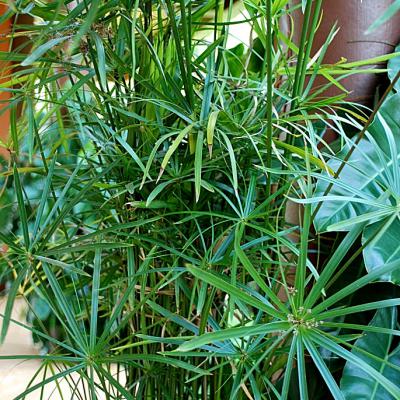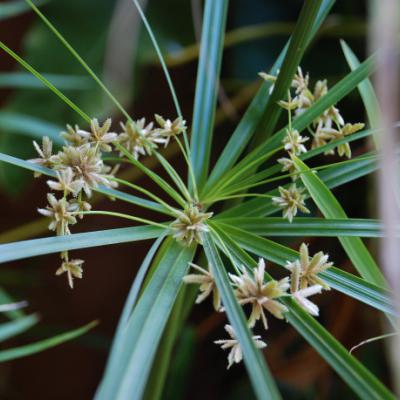Cyperaceae-Cyperus-alternifolius
Classification
- Botanical Family : Cyperaceae
- Genus : Cyperus
- Epithet : alternifolius
- German Family Name: Sauergrasgewächse / Riedgrasgewächse
- English Name: Umbrella Plant, Umbrella Sedge, Galingale, Papyrus
- Thai Name: กกลังกา
- Thai Phonetic: kok lang kaa
- Author: L.
- Height: 1.50
Water Requirements
Plant Type
Light Requirements
Cultivation
Cyperus alternifolius is an evergreen, perennial and grass-like plant with up to 2 m long stalks. It is native in Madagascar, but now it is cultivated worldwide in the tropics.
The flowers are cream-colored, small, rather inconspicuous and grow in clusters. They are surrounded by up to 25 cm long, green bracts.
Occasionally new growth form on the leaves, which has an inflorescence too, with bracts that vary considerably smaller than in the mother plant.
The rhizome (root) is creeping and relatively short. The sprouting of new stems from the new nodes are always on the young end of the rhizome, making the plant "moveing" slowly.
Due to the high demand for water Cyperus alternifolius do best in water edges and in fishponds (should be planted in a container before you put it in the Pond, use gravel or sand as a substrate). Also, the plant is suitable for keeping in a large clay pot, which should be sufficiently filled with water. Planting in the ground is not a problem if it is often watered.
Partial shade or morning and evening sun are ideal. When the plant is established Cyperus alternifolius tolerates also full day sunlight.
Dead stems should be cut out regularly.
Propagation:
- By division of larger plants.
- Or by rooting the bracts, which still do not flowering. Reduce the length of the leaves and the stem to 5 cm and put it upside down in a glass of water. All leaves should be covered with water. After rooting, the plant can be repotted.
- Or instead to put in a glass of water put the leave crown in pure sand and keep it moist.
Cyperus alternifolius ist eine immergrüne, ausdauernde und grasartige Pflanze mit bis zu 2 m langen Halmen. Beheimatet ist sie in Madagaskar, jedoch ist sie weltweit in den Tropen kultiviert.
Die Blüten sind cremefarbig, klein, eher unauffällig und wachsen in Büscheln. Sie sind umgeben von den bis zu 25 cm langen grünen Hochblättern.
Gelegentlich bilden sich an den Blattansätzen neue Triebe aus, die ihrerseits einen Blütenstand mit Hochblättern tragen, die jedoch wesentlich kleiner ausfallen, als bei der Mutterpflanze.
Das Rhizom (Wurzel) ist kriechend, relativ kurz. Der Austrieb neuer Halme erfolgt immer aus den neuen Nodien am jungen Ende des Rhizoms, wodurch die Pflanze langsam „wandert“.
Aufgrund des hohen Wasserbedarfs gedeiht Cyperus alternifolius am besten an Gewässerrändern und in Fischponds (sollte im Topf in den Pond gestellt werden mit Kiesel oder Sand als Substrat). Auch eignet sich die Pflanze zur Haltung in einem großen Tontopf ohne Substrat, der ausreichend mit Wasser gefüllt sein sollte. Das Einpflanzen in Erde ist auch kein Problem, wenn ausreichend und oft gegossen wird.
Halbschatten oder Vormittags- und Abendsonne sind ideal. Nach der Eingewöhnung von älteren Pflanzen verträgt Cyperus alternifolius auch einen voll sonnigen Platz.
Abgestorbene Halme sollten regelmäßig heraus geschnitten werden.
Vermehrung:
-durch Teilung größerer Pflanzen
- oder durch Bewurzelung der Hochblätter, die noch keine Blüten tragen. Man schneidet einen Halm mit Blattschopf ab, kürzt die Blätter bis auf 5 cm ein, ebenso den Blattstiel, und stellt das ganze kopfüber in ein Glas Wasser. Alle Blätter müssen mit Wasser bedeckt sein. Nach der Bewurzelung kann die Pflanze eingetopft werden.
- Oder statt in einem Glas Wasser den Blattschopf in reinem Sand bewurzeln lassen, der stets feucht gehalten werden sollte.
Origin
Miscelaneous
Ethnomedical uses
The ethnomedical information is provided for general information only, it is not intended as guidance for medicinal use.
Roots and leaves are used.
Results of studies:
The root and leaf-stem extracts from Cyperus alternifolius showed a moderate activity against all yeasts, while the root extract produced a clear antioxidant activity.
It was also confirmed in this study that Cyperus alternifolius has strong antimicrobial properties. (1)
Volksmedizinische Verwendung
Die Berichte über volksmedizinische Verwendung ist nur zur allgemeinen Information und nicht als medizinischer Ratgeber zu betrachten.
Verwendet werden die Wurzel und Blätter.
Eine Studie ergab, dass die Blatt-Auszüge aus Cyperus alternifolius eine moderate Aktivität gegen alle Hefen zeigten, während die Wurzel-Extrakt eine klare antioxidative Aktivität aufwiesen.
Weiterhin wurde in der Studie bestätigt, dass Cyperus alternifolius starke antimikrobielle Eigenschaften besitzt. (1)
References
(1) Antimicrobial and Antioxidant Activities of Plants from Northeast of Mexico
Departamento de Química Analítica, Facultad de Medicina, U.A.N.L. Monterrey, P.O. Box 2316, Sucursal Tecnol579gico, 64841, N. L. México, Mexico
Received 5 March 2009; Accepted 21 July 2009
Evidence-Based Complementary and Alternative Medicine
Volume 2011 (2011), Article ID 536139, 6 pages
doi:10.1093/ecam/nep127 http://www.hindawi.com/journals/ecam/2011/536139/


